
In the practice of Christianity, canonical hours mark the divisions of the day in terms of fixed times of prayer at regular intervals. A book of hours, chiefly a breviary, normally contains a version of, or selection from, such prayers.

The Valaam Monastery is a stauropegic Orthodox monastery in Russian Karelia, located on Valaam, the largest island in Lake Ladoga, the largest lake in Europe.
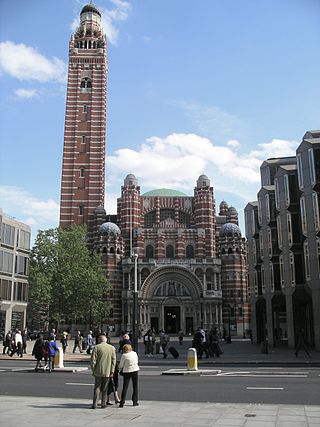
The Metropolitan Cathedral of the Most Precious Blood, known as Westminster Cathedral, is the largest Roman Catholic church in England and Wales and the seat of the Cardinal Archbishop of Westminster.
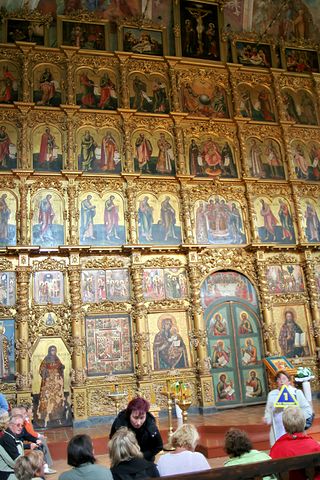
The Byzantine Rite, also known as the Greek Rite or the Rite of Constantinople, is a liturgical rite that is identified with the wide range of cultural, devotional, and canonical practices that developed in the Eastern Christian church of Constantinople.

Byzantine music originally consisted of the songs and hymns composed for the courtly and religious ceremonial of the Byzantine Empire and continued, after the fall of Constantinople in 1453, in the traditions of the sung Byzantine chant of Eastern Orthodox liturgy. The ecclesiastical forms of Byzantine music are the best known forms today, because different Orthodox traditions still identify with the heritage of Byzantine music, when their cantors sing monodic chant out of the traditional chant books such as the Sticherarion, which in fact consisted of five books, and the Irmologion.
A kontakion is a form of hymn in the Byzantine liturgical tradition.
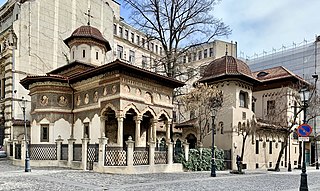
Stavropoleos Monastery, also known as Stavropoleos Church during the last century when the monastery was dissolved, is an Eastern Orthodox monastery for nuns in central Bucharest, Romania. Its church is built in Brâncovenesc style. The patrons of the church are St. Archangels Michael and Gabriel. The name Stavropoleos is the genitive case of Stavropolis. One of the monastery's constant interests is Byzantine music, expressed through its choir and the largest collection of Byzantine music books in Romania.

The kliros is the section of an Eastern Orthodox, Armenian, or Eastern Catholic church dedicated to the choir. It refers both to the general space in which chanters or singers assemble for the services, as well as to the actual music stand or shelves on which music is stored and read.

Simonopetra Monastery, also Monastery of Simonos Petra, is an Eastern Orthodox monastery in the monastic state of Mount Athos in Greece. It ranks 13th in the hierarchy of the Athonite monasteries.
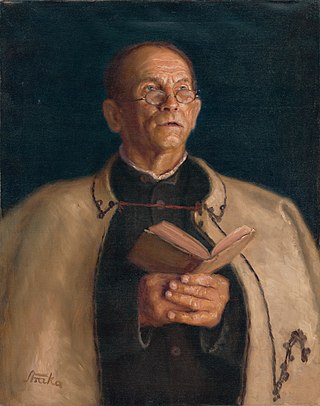
In Christianity, the cantor, female chantress, sometimes called the precentor or the protopsaltes, is the chief singer, and usually instructor, employed at a church, with responsibilities for the choir and the preparation of the Mass or worship service. The term is also used for a similar task in Reform Judaism and in Ancient Egypt.

Xenophontos Monastery is an Orthodox Christian monastery in the monastic state of Mount Athos in Greece.

A typikon is a liturgical book which contains instructions about the order of the Byzantine Rite office and variable hymns of the Divine Liturgy.

Eastern Orthodox church architecture constitutes a distinct, recognizable family of styles among church architectures. These styles share a cluster of fundamental similarities, having been influenced by the common legacy of Byzantine architecture from the Eastern Roman Empire. Some of the styles have become associated with the particular traditions of one specific autocephalous Eastern Orthodox patriarchate, whereas others are more widely used within the Eastern Orthodox Church.
Eastern Orthodox worship in this article is distinguished from Eastern Orthodox prayer in that 'worship' refers to the activity of the Christian Church as a body offering up prayers to God while 'prayer' refers to the individual devotional traditions of the Orthodox.
The Polyeleos is a festive portion of the Matins or All-Night Vigil service as observed on higher-ranking feast days in the Eastern Orthodox, Eastern Lutheran, and Byzantine Rite Catholic Churches. The Polyeleos is considered to be the high point of the service, and contains the reading of the Matins Gospel. Because of its liturgical importance, settings for the Polyeleos have been composed by Sergei Rachmaninoff and others.
The Lity or Litiyá is a festive religious procession, followed by intercessions, which augments great vespers in the Eastern Orthodox and Byzantine Catholic churches on important feast days. Following a lity is another liturgical action, an artoklasia, and either of these terms may be used to describe both liturgical actions collectively.

Solon J. Hadjisolomos is a Cypriot musicologist.
Manuel Doukas Chrysaphes was the most prominent Byzantine musician of the 15th century.
Simon Karas was a Greek musicologist, who specialized in Byzantine music tradition.
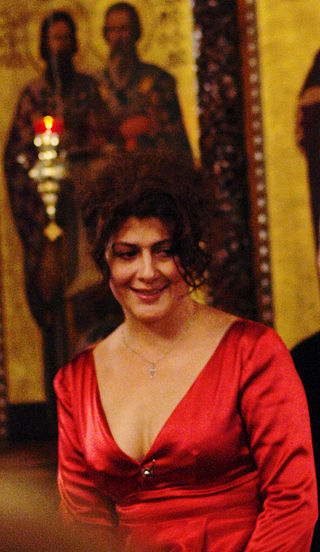
Divna Ljubojević, sometimes called by just her first name, Divna, is a Serbian singer and conductor of Orthodox Christian sacred music in various languages. She is the conductor and artistic director of the Melodi ensemble, a "choir and studio for spiritual music". which she founded with a group of her friends.













